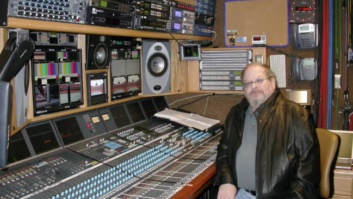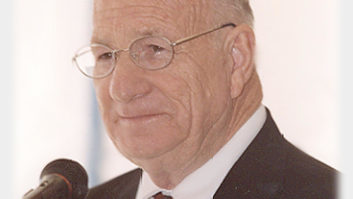Photos
(click thumbnail)Ed Perry at a base from Fessenden’s Brant Rock towers, located in what is now an RV park. Photos by Garrett Wollman.
(click thumbnail)Station owners Barry Lunderville, Marshall Sanft, Dennis Jackson and Ed Perry, from left, share the mic.
(click thumbnail)Fessenden’s towers used an array of smaller insulators, rather than the large style now found at AM sites. A hundred years since the human voice and music were first sent out over the airwaves, broadcasters and historians are rescuing the “world’s first broadcaster” from obscurity.
Even within the radio community, the name Reginald Aubrey Fessenden has never carried the same historic connotations as some of the industry’s better-known pioneers, such as Marconi, Armstrong and Sarnoff. Yet Fessenden’s experiments at the turn of the 20th century bridged the gap between Marconi’s code transmissions and the voice and music broadcasts that would quickly become synonymous with “radio,” providing crucial early breakthroughs that included the discovery of the heterodyne receiver principle and the invention of the high-frequency alternator.
Though he was born in Canada, Fessenden’s seminal work took place on the coast of Massachusetts at an isolated spit of land 30 miles southeast of Boston called Brant Rock, in the town of Marshfield. Fortunately for Fessenden’s legacy, Marshfield is today the home of WATD(FM), the sole broadcast property of Ed Perry, known to friends as one of the most committed community broadcasters in the country.
Recreation
As early as 1991, Perry began restoring Fessenden to the local consciousness, staging a celebration of the 85th anniversary of the Brant Rock broadcasts. But the impending arrival of the 100th anniversary gave Perry the opportunity to do something much bigger, in the form of multiple celebrations that will culminate on Christmas Eve with a recreation of Fessenden’s first broadcast.
“Fessenden-fest” in Marshfield began in August, when WATD staged a daylong remote broadcast from the Daniel Webster Estate. Guests included David Wolfe, son of Fessenden’s patent attorney; veteran Boston broadcaster Fred B. Cole, now 91; Canadian historian and journalism professor Len Arminio; and several of Perry’s counterparts in community station ownership around New England. Checking in by telephone from the coast of Scotland was Duncan MacGregor, GM3TNT, one of several hams working on preserving the Fessenden legacy at the site of his receiving station in Machrihanish, Scotland, where the first trans-Atlantic voice communications were picked up back in 1906.
The August Fessenden weekend also included historic tours, live music and an evening banquet at which the first “Reginald A. Fessenden Broadcasting Award” was presented to Gary LaPierre, veteran morning news anchor at Boston’s WBZ.
Symposium
That, however, was only act one in the Fessenden centennial celebration. On Oct. 7, Marshfield’s Isaac Winslow House was the setting for the next piece of the party, a daylong symposium on Fessenden’s life and legacy.
Marc Jacques of the Canadian consulate in Boston discussed Fessenden’s early years north of the border, which ended when he was turned down for a professor position at Montreal’s McGill University. That turned out to be a stroke of luck for the future of broadcasting, since it propelled Fessenden south to New Jersey and the laboratories of Thomas Edison, where he earned the respect of the legendary inventor and gained exposure to the cutting edge of electrical technology, circa 1890.
After a stint at the University of Pittsburgh, Fessenden ended up in the employ of a new company called the National Electric Signaling Company (NESCO), which funded Fessenden’s 400-foot towers and transmitting equipment at Brant Rock.
There’s no doubt that by 1906, Fessenden was successfully using a rotary spark-gap transmitter (the antecedent of the high-frequency alternator that Fessenden and General Electric’s Ernst F.W. Alexanderson developed) to transmit audio over a crude facsimile of a continuous wave. With the arrival of one of Alexanderson’s first working alternators that December, the stage was set for those historic “first broadcasts.”
At the October seminar, broadcast historian Donna Halper of Emerson College cast some doubt on the story that’s been passed down through history, the story that the very first broadcast took place on Christmas Eve 1906, with Fessenden reading bible passages and playing “O Holy Night” on his violin.
Fessenden never spoke of a Christmas Eve broadcast at the time and only mentioned it once, in a 1932 letter just before his death. If such a broadcast did happen, Halper says, it may well have been a bit of holiday fun amidst more serious experiments and demonstration broadcasts that took place, fully documented, on other dates in December. It’s entirely possible, she suggests, that the shipboard radio operators who heard Fessenden’s broadcasts may even have been annoyed at the interruption to the Morse Code weather transmissions they were listening for, rather than amazed at the magical sounds in their headphones, as the legend says. (Also see “Fessenden: World’s First Broadcaster?” in the Oct. 25 RW.)
RV park
The October seminar included talks on broadcasting history by Boston University journalism professor Nick Mills; and I spoke about the few remaining physical artifacts of the earliest radio transmitter facilities that are still standing.
That includes the base of Fessenden’s Brant Rock tower, which sat on a sandwich of concrete slabs and small ceramic insulators. Today, the concrete is cracked and crumbling and many of the insulators are broken, and the base sits incongruously in the middle of what’s now an RV park by the shore, with only a small plaque telling its story. (Only in the last few years have historians identified two houses nearby as having been built for Fessenden’s staffers. They’ve also tentatively identified a small shed as an early transmitter shack.)
Acts 3 and 4 of the Fessenden revival will take place in December. Whether or not historical research supports the Christmas Eve legend, Perry says the story is simply too good to pass up; and so on Dec. 24, WATD will be broadcasting live from the Fessenden tower site, presenting a recreation of the 1906 transmission. In one concession to 2006 listening habits, Perry says the recreation will take place early in the day, rather than late at night.
A few days later, the hams will take center stage, as MacGregor and his colleagues in Scotland set up a station at the original Fessenden site in Machrihanish, using the special-event call GB1FVT (“First Voice Transmission”). At the same time, a team led by Steve Barreres, K2CX (whose day job is with ABC in New York) will set up at Brant Rock under the special-event call W100BO/W1F (“100” for the centennial, and “BO” for the calls Fessenden used at Brant Rock).
The Dec. 29–30 event will culminate a year of Fessenden celebrations in the amateur radio community, where the American Radio Relay League has been promoting the centennial with the “Hello” campaign, commemorating the first word Fessenden supposedly said over the air in an early voice experiment in 1900.
The final word, perhaps, comes from Machrihanish, where MacGregor and other local Fessenden buffs have also been taking the story of “Radio’s First Voice” into the local elementary school. Students there have been studying the Fessenden story and corresponding with pen pals “across the pond” in Marshfield. Is it too much to hope that some of them will be active in the Fessenden sesquicentennial, half a century from now?















